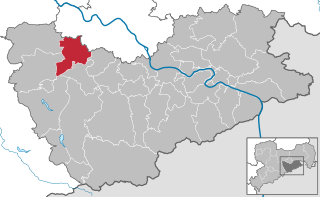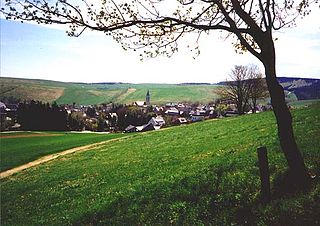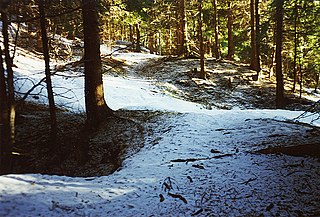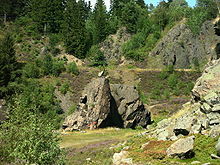
Annaberg-Buchholz is a town in Saxony, Germany. Lying in the Ore Mountains, it is the capital of the district of Erzgebirgskreis.

Hohenstein-Ernstthal is a town in the Zwickau rural district, Saxony, Germany. The towns of Hohenstein and Ernstthal were united in 1898, and the town is either known by its hyphenated form, or simply called Hohenstein.

Pegau is a town in the Leipzig district in Saxony, Germany, situated in a fertile plain, on the White Elster, 18 m. S.W. from Leipzig by the railway to Zeitz.

Eibenstock is a town in the Erzgebirgskreis, Saxony, Germany. It is situated in the western Ore Mountains, near the river Mulde.

Marienberg is a town in Germany. It was the district capital of the Mittlerer Erzgebirgskreis in the southern part of Saxony, and since August 2008 it has been part of the new district of Erzgebirgskreis. As of 2020, the town had 16,716 inhabitants.

The narrow-gauge railways in Saxony were once the largest single-operator narrow-gauge railway network in Germany. In Saxony, the network peaked shortly after World War I with over 500 km (311 mi) of tracks. At first, it was primarily created to connect the small towns and villages in Saxony – which had formed a viable industry in the 19th century – to already established standard-gauge railways. But even shortly after 1900, some of the railways would become important for tourism in the area.

Freital is a town in the district of Sächsische Schweiz-Osterzgebirge in Saxony, Germany. The town is situated on a small river, the Weißeritz, and is eight kilometres (5 mi) southwest of Dresden.

Altenberg is a town in the Sächsische Schweiz-Osterzgebirge district, in Saxony, Germany.

Grünhain-Beierfeld is a town in the district of Erzgebirgskreis in Saxony, Germany lying 8 km east of Aue. It came into being on 1 January 2005 through the merger of the town of Grünhain and the community of Beierfeld.

Oberwiesenthal is a town and a ski resort in the district of Erzgebirgskreis in Saxony in Germany. It is situated in the Ore Mountains, on the border with the Czech Republic, 19 km south of Annaberg-Buchholz, and 23 km northeast of Karlovy Vary. At 914 metres (2,999 ft), it is the highest town in Germany. The Olympic and World Championships goldmedalist in ski jumping Jens Weißflog competed for SC Tractor Oberwiesenthal and Oberwiesenthaler SV.

Thum is a small town in the district of Erzgebirgskreis in Saxony, Germany. It has a population of about 5,000.

Wolkenstein is a town in the district Erzgebirgskreis, in Saxony, Germany. It is situated in the Ore Mountains, on the river Zschopau, 22 km southeast of Chemnitz.

The town of Seiffen is located in the district of Erzgebirgskreis, which is in the central south of the Free State of Saxony in Germany. The earliest record of the town dates to 1324 when it was referred to as "Cynsifen".

Schönheide is a municipality in Saxony's district of Erzgebirgskreis. It lies in the western Ore Mountains, and was founded as an industrial village.

Sosa is a former municipality in the western Ore Mountains, in the Erzgebirgskreis, Saxony, Germany. It is a state-recognized health resort, that has belonged to the town Eibenstock since 1 January 2011.

Stützengrün is a community in the district of Erzgebirgskreis, Saxony, Germany.

Oybin is a municipality in the Görlitz district, in Saxony, Germany, located very close to the border of the Czech Republic. Following the defeat of the Protestant armies by the Habsburgs in the Battle of the White Mountain in 1620, many Protestant Czechs found refuge across the border in the hills of Upper Lusatia. It is a "Kurort", a resort or spa certified by the state, where people go for rest and recuperation. It is most famous for its mountain of the same name, an exposed natural sandstone dome that towers above the town. The ruins of a medieval monastery lend a wild romantic beauty to it and it was a favorite subject of 19th-century Romantic painters like Caspar David Friedrich. Many bizarrely shaped geological rock formations can be found in the surroundings. The scenic narrow gauge Zittau–Kurort Oybin/Kurort Jonsdorf railway runs from Oybin to Bertsdorf, from there to the neighboring municipality of Jonsdorf and the town of Zittau. Oybin municipality has 3 districts: Oybin, Hain and Lückendorf.

The German Class 99.73-76 engines were standard locomotives (Einheitslokomotiven) in service with the Deutsche Reichsbahn for Saxony's narrow gauge railways. Together with their follow-on class, the DR Class 99.77-79, they were the most powerful narrow gauge locomotives in Germany for the 750 mm track gauge.

The Thumer Netz was a narrow gauge railway network in the area around Thum in Saxony, Germany that operated from 1886 until 1975. It had a 750 mm gauge. Total length was about 44 km (27.34 mi).

A Pinge or Binge ("binger") is the name given in German-speaking Europe to a wedge-, ditch- or funnel-shaped depression in the terrain caused by mining activity. This depression or sink-hole is frequently caused by the collapse of old underground mine workings that are close to the Earth's surface. Unlike natural landforms, a Pinge is a direct result of human activity. The term has no direct equivalent in English, but may be translated as "mining sink-hole", "mine slump" or, in some cases, as "glory hole".





























